Materials
Understanding the Different Metals and Alloys Used for Wall Decor
The world of metal wall art is a captivating interplay of materials, each bringing its distinct character and story. From the warm, burnished tones of copper and rustic iron to the sleek, industrial edge of steel, the choice of metal is more than just an aesthetic decision – it’s a canvas upon which your unique vision can come to life.
Whether you’re drawn to the vintage sophistication of brass, the rich, earthy elegance of bronze, or the luxurious sheen of silver and gold, exploring the different metals and alloys used in metal wall art is a journey through the enduring allure of nature’s most precious elements.
Read on to discover how these materials can transform a simple piece into a true celebration of craftsmanship, creativity, and the art of storytelling through metal.
1. Copper – Nature’s Artisan
Copper’s warm, reddish-brown hue instantly adds a rustic, southwestern charm to any space. One of its most captivating qualities is its natural ability to develop a rich patina over time. Imagine polished copper wall art pieces glistening like burnished gems or the earthy, organic tones of an oxidized patina complementing your nature-inspired decor.
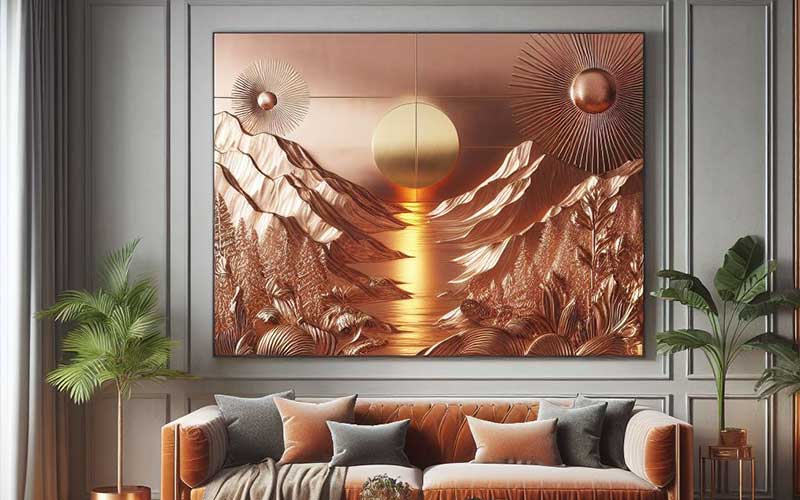
Here’s a little insider secret: copper can patina unevenly indoors, creating a mottled, almost tie-dyed effect. Some find this beautifully unique, while others prefer a more uniform look. Sealing the copper will help maintain its original luster in the latter case.
2. Iron – Rustic Resilience
Iron’s raw, rugged appeal has an undeniable charm. Whether you embrace its natural tendency to rust or prefer a freshly painted finish, iron wall art exudes a timeless, vintage vibe that adds warmth and character to any space.
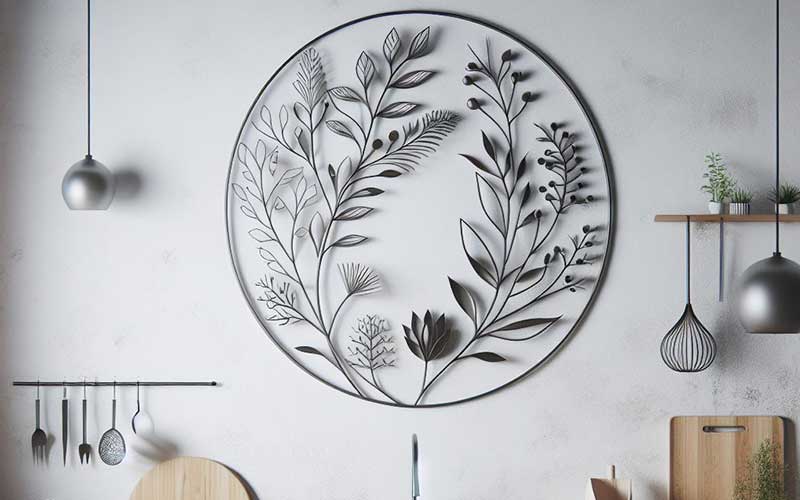
Raw Iron
There’s something undeniably charming about raw iron’s natural propensity to rust. Whether you embrace the weathered, timeless patina or prefer a freshly painted finish, raw iron wall art exudes a vintage, industrial vibe that’s hard to resist.
Cast Iron
Cast iron’s rough, almost brutalist texture is a bold statement in itself. Imagine intricate, bas-relief designs or abstract wall sculptures that command attention with their raw, industrial appeal. Just remember, cast iron is heavy – you might need extra support to keep those wall pieces securely in place.
Wrought Iron
If iron could be an art form, wrought iron would be its magnum opus. Expertly forged into intricate, ornamental designs, wrought iron wall art screams “traditional elegance” with a hint of Gothic romance. Its blackened hues and textured finishes add depth and drama to any space, from elaborate gates to delicate scrollwork.
3. Steel – Durable and Strong
Steel, an alloy primarily composed of iron and carbon, is the true chameleon of the metal world, effortlessly adapting to suit any style or aesthetic. From sleek and modern to rustic and industrial, this versatile material can be transformed into wall art that perfectly captures your desired vibe.
Plain Carbon Steel
Durable, affordable, and undeniably industrial, plain carbon steel is the chameleon of the metal world. With finishes ranging from sleek polished surfaces to brushed textures or intentionally rusted abstracts, it effortlessly captures modern, minimalist, or edgy vibes.
Galvanized Steel
Remember that one friend who always had your back, no matter the weather? That’s galvanized steel. Its zinc coating provides rust resistance, making it ideal for outdoor wall art, garden sculptures, or other pieces that must withstand the elements.
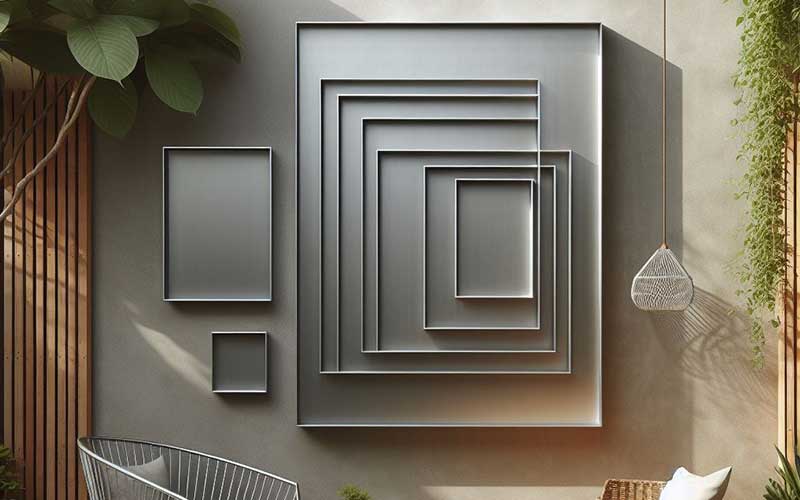
Stainless Steel
Sleek, low-maintenance, and highly durable, stainless steel is the epitome of contemporary cool. Its polished or brushed finishes lend a sophisticated, almost futuristic touch to minimalist or abstract wall art designs. Just be prepared for those pesky fingerprints and smudges – stainless steel’s mirror-like sheen is a double-edged sword!
4. Lightweight Aluminum
Aluminum may be lightweight, but it packs a serious punch in the style department. Its polished or brushed finishes lend a sleek, modern vibe to geometric or nature-inspired wall art designs. But the real fun begins with anodized colors – imagine vibrant hues or iridescent shimmer transforming aluminum into a contemporary masterpiece.
Just be warned: aluminum can be a bit of a diva. Those dents and scratches? They’ll show. But hey, a few “battle scars” only add character, right?
5. Alloys: Metal Mavericks
When metals join forces, the results are truly remarkable. From the warm, golden hues of brass to the rich, earthy patinas of bronze, alloys bring a unique depth and character to wall art that can’t be replicated with pure metals alone. We’ve already talked about steel. Here are more details about the other alloys.
Brass
Brass, the golden child of the alloy family, tarnishes naturally into an antique patina that channels vintage, art deco, or industrial vibes. Imagine intricate brass wall sculptures or embossed panels that look like they’ve been plucked straight from a bygone era.
Bonus tip: brass loves a good polish! A little elbow grease will bring out its warm, golden glow and keep those tarnished tones at bay (at least for a while).
Bronze
With its rich, earthy patina, Bronze epitomizes timeless elegance. Intricate bronze castings featuring classical motifs or nature-inspired designs instantly elevate any space, lending it a touch of traditional grandeur.
Fair warning: bronze’s beauty comes at a price – both in cost and the specialized skills required for casting and finishing. But for those who appreciate the finer things in life, it’s an investment worth making.
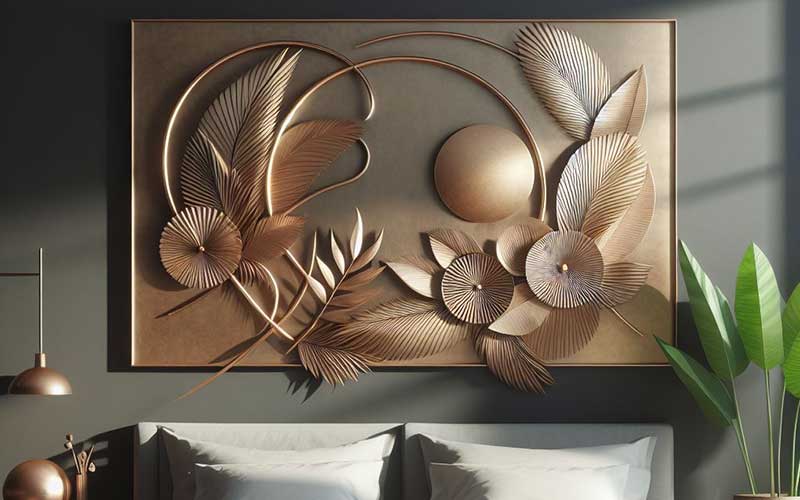
Pewter
Pewter, the unassuming alloy with a dull gray hue, is perfect for those seeking a more subdued, understated elegance. Imagine decorative wall pieces inspired by vintage tableware or jewelry, their subtle textures and patterns catching the eye without overwhelming the senses.
Just handle pewter carefully – it’s softer than other metals and prone to denting or scratching. Treat it like the delicate gem it is, and it’ll reward you with timeless beauty.
6. Other Metals:
While less common in wall art, precious metals like silver, gold, and titanium offer unmatched luxury and exclusivity. These rare and exquisite materials elevate wall art pieces into true statement-making masterpieces designed to dazzle and delight.
Silver
Silver, the reflective, highly malleable metal, is a true showstopper in wall art. From contemporary, minimalist designs to intricate art deco motifs, silver wall pieces exude an air of sophistication and luxury.
But with great beauty comes great responsibility (and a hefty price tag!). Silver requires careful handling and regular polishing to maintain its brilliant shine and prevent tarnishing. Consider it an investment in opulence – one that’s sure to dazzle and delight.
Titanium
Titanium, the space-age metal that’s lightweight yet highly corrosion-resistant, brings a touch of sci-fi flair to wall art designs. Its brushed or anodized finishes (albeit limited in color options) lend a futuristic, almost otherworldly vibe that will turn heads.
Of course, titanium’s rarity and difficulty in working with it make it an expensive and exclusive choice. But for those seeking truly unique, cutting-edge wall art, it’s a material out of this world.
Gold
And last but certainly not least, we have gold – the epitome of luxury and opulence. Whether incorporated as accents or used in pure, lustrous form, a touch of gold instantly elevates any wall art piece into a regal, showstopping masterpiece.
Prepare to indulge in decadence – gold’s extravagance comes with a premium price tag. But for those who appreciate the finer things in life, a gilded wall art piece is a true investment in timeless beauty and sophistication.
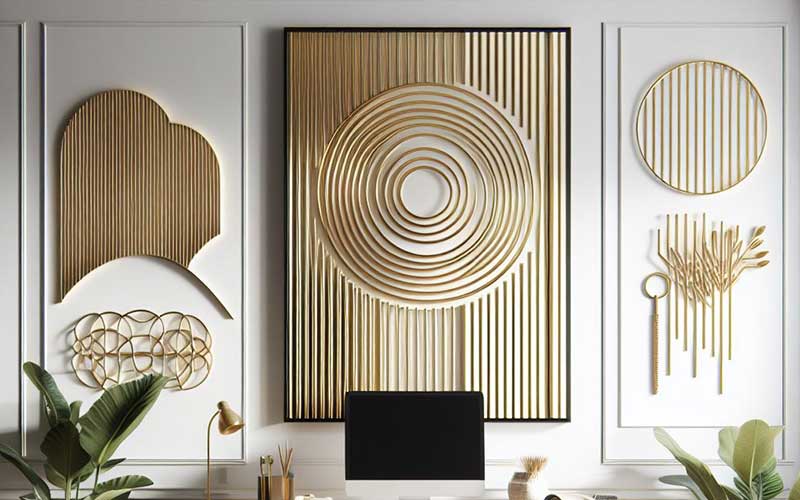
Tin
Tin, the humble, surprisingly malleable, and affordable metal, lends itself perfectly to folk art-inspired wall pieces. Embossed patterns, raised textures, and vibrant colors transform tin into whimsical, rustic treasures that add a touch of whimsy to any space.
Just be mindful of tin’s susceptibility to corrosion over time. A little TLC (and maybe a protective sealant) will ensure your tin wall art remains a cherished heirloom for generations to come.
Below is a table highlighting the many metals and alloys for wall décor
| Material | Properties | Appearance | Applications | Considerations |
| Copper | Warm, reddish-brown color, naturally patinas, malleable | Can be polished, brushed, oxidized, patinated | Industrial, rustic, southwestern, nature-inspired | Can patina unevenly, may require sealing for indoor use |
| Steel | Strong, durable, readily available, affordable | Can be polished, brushed, rusted, painted | Industrial, modern, minimalist, abstract | Can rust outdoors, may require heavier gauge for larger pieces |
| Galvanized Steel | Strong, durable, rust-resistant (zinc coating) | Dull gray color | Industrial, outdoor furniture, fencing | Zinc coating can chip or scratch, may require touch-ups |
| Stainless Steel | Highly durable, rust-resistant, low maintenance | Polished, brushed, mirror-finished | Modern, minimalist, contemporary, abstract | Can be expensive, may show fingerprints or smudges |
| Iron | Strong, durable, naturally rusts, heavier than steel | Can be polished, brushed, painted, rusted | Rustic, industrial, vintage, abstract | Rusts readily, requires maintenance, heavier weight may require additional support |
| Wrought Iron | Strong, durable, heavy, forged | Black with a rough texture | Ornamental, traditional, furniture | Prone to rusting, requires maintenance and painting |
| Cast Iron | Strong, heavy, brittle | Black or gray, rough texture | Industrial, vintage, rustic | Very heavy, can crack or break if dropped |
| Aluminum | Lightweight, rust-resistant, versatile | Can be polished, brushed, anodized, colored | Modern, contemporary, geometric, nature-inspired | May dent or bend easily, can show scratches more readily |
| Brass | Warm, golden color, tarnishes naturally, polishes well | Can be polished, brushed, antiqued, patinated | Industrial, vintage, art deco, geometric | Will tarnish and require polishing, may be more expensive |
| Pewter | Durable, low-melting point, easily cast | Dull gray color, can be polished | Decorative items, tableware, jewelry | Softer than other metals, can dent or scratch |
| Bronze | Strong, durable, develops a natural patina, can be cast | Can be polished, brushed, patinated, colored | Traditional, classical, rustic, art deco | Can be expensive, patina can vary, casting requires specialized skills |
| Tin | Lightweight, malleable, readily available, affordable | Can be painted, embossed, patterned | Rustic, vintage, country, folk art | May dent or bend easily, can be susceptible to corrosion |
| Silver | Highly malleable, reflective, expensive | Polished, brushed, oxidized, antiqued | Contemporary, minimalist, art deco, jewelry-inspired | Very expensive, requires careful handling and cleaning, prone to tarnishing |
| Titanium | Strong, lightweight, highly corrosion-resistant | Brushed, polished, anodized (limited colors) | Modern, minimalist, sci-fi inspired | Very expensive, difficult to work with, limited availability |
Additional Details to Consider When Choosing a Metal Type for Wall Art
While the information above outlines the key properties and considerations of various metals, choosing the right one for your wall art requires looking beyond the basics. Here are some additional factors to consider:
1. Style and Theme of Your Space
Selecting the suitable metal for your wall art is more than just aesthetics – it’s about creating a cohesive, harmonious vibe that ties your entire space together. Think of it as a delicate dance between the metal’s inherent personality and the overall theme you’re aiming for.
If you’re rocking an industrial or modern space, steel, aluminum, or copper are your partners in crime. Their sleek, contemporary vibes will have your walls looking sharper than a freshly-pressed suit. But if rustic or vintage is more your style, iron, bronze, or tin will wrap you in a warm, lived-in embrace like your favorite cozy sweater.
For those minimalist or contemporary sanctuaries, stainless steel, silver, or titanium epitomizes chic simplicity. Their clean lines and reflective qualities make your space feel as fresh and airy as a crisp spring morning.
And let’s not forget about color! Choosing a metal that complements your palette is vital to creating a harmonious flow. Imagine the warm glow of brass or bronze adding depth to a cool-toned space or the modern elegance of silver or titanium offering a touch of sophistication to a neutral oasis.
2. Placement and Functionality
Hold up, though – it’s not just about looks! Functionality is also crucial in choosing the suitable metal for your wall art.
If your piece is destined for the great outdoors, you’ll want to steer clear of metals like iron or copper that rust naturally. Unless you’re aiming for that weathered, bohemian vibe – in which case, a little rust never hurt anyone!
Speaking of size, don’t underestimate the heft of certain metals. Larger pieces crafted from heavyweights like iron or bronze might need extra support to keep them securely in place. Trust me, you don’t want your prized wall art taking an impromptu dive onto the floor!
And let’s not forget about maintenance. Some metals, like brass or silver, require regular polishing to maintain their radiant glow, while others, like stainless steel, are practically low-maintenance royalty. So, consider your willingness to put in a little elbow grease before committing to a high-maintenance metal crush.
3. Budget and Availability
Ah, yes – the age-old question of cost and accessibility. Certain metals, like silver, titanium, and bronze, tend to carry a heftier price tag than their more modest counterparts, like steel, aluminum, or tin. Sometimes, you have to splurge for that perfect piece, am I right?
Let’s not overlook availability. Certain metals might be more readily available than others depending on where you live, influencing the ease of acquisition and potentially impacting the overall cost. So, it’s always wise to research and see what’s readily accessible in your area.
4. Sustainability
In today’s eco-conscious world, it’s essential to consider the environmental impact of your choices – even when it comes to wall art. Why not explore recycled or reclaimed metal options? Not only are you doing your part to reduce waste, but you’re also adding a unique, one-of-a-kind touch to your space.
While you’re at it, look for metals that require minimal finishing processes. The fewer chemicals or resources needed to transform that raw material into a work of art, the better for our planet (and your peace of mind!).
No matter which metal (or metals!) you choose, the key is finding pieces that resonate with your style and the vibe you want to create in your space. So go ahead and explore the world of metal wall art – it’s a journey that’s as unique, engaging, and captivating as the materials themselves!

